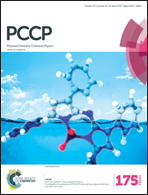Detection of trapped charges in the blend films of polystyrene/SFDBAO electrets by electrostatic and Kelvin probe force microscopy†
Abstract
The charge trapping properties of the blend of polystyrene (PS) and a sterically hindered organic semiconductor SFDBAO (spiro[fluorene-9,7-dibenzo[c,h]acridin-5-one]) are investigated by electrostatic and Kelvin probe force microscopy (EFM and KPFM). EFM signals of trapped charge spots injected with controllable tip biases, which are recorded with different dissipation times t, the percent of SFDBAO in blends, and the scanning tip bias, have been measured. By the quantitative analysis, the excellent trapped charge density of PS/SFDBAO blend films for the holes (∼×10−5 C m−2) is much higher than that of the SFDBAO film (∼×10−6 C m−2) and the PS film (∼×10−7 C m−2). However, the trapped charge density of electrons (∼×10−7 C m−2) has the same order magnitude for SFDBAO, PS and the blend films. The results indicate that the blend of PS and SFDBAO enhances the high-density storage and retention abilities of the holes to a larger extent, but the endurance improvement of the electrons is not that obvious. By the KPFM measurement, we further verify the different diffusion rates of the trapped holes and electrons in the PS/SFDBAO blend films, and discuss the possible physical mechanism. The qualitative and quantitative determination of charge trapping properties in this work can be very useful for the characterization of PS/SFDBAO based charge trapping memory devices.


 Please wait while we load your content...
Please wait while we load your content...